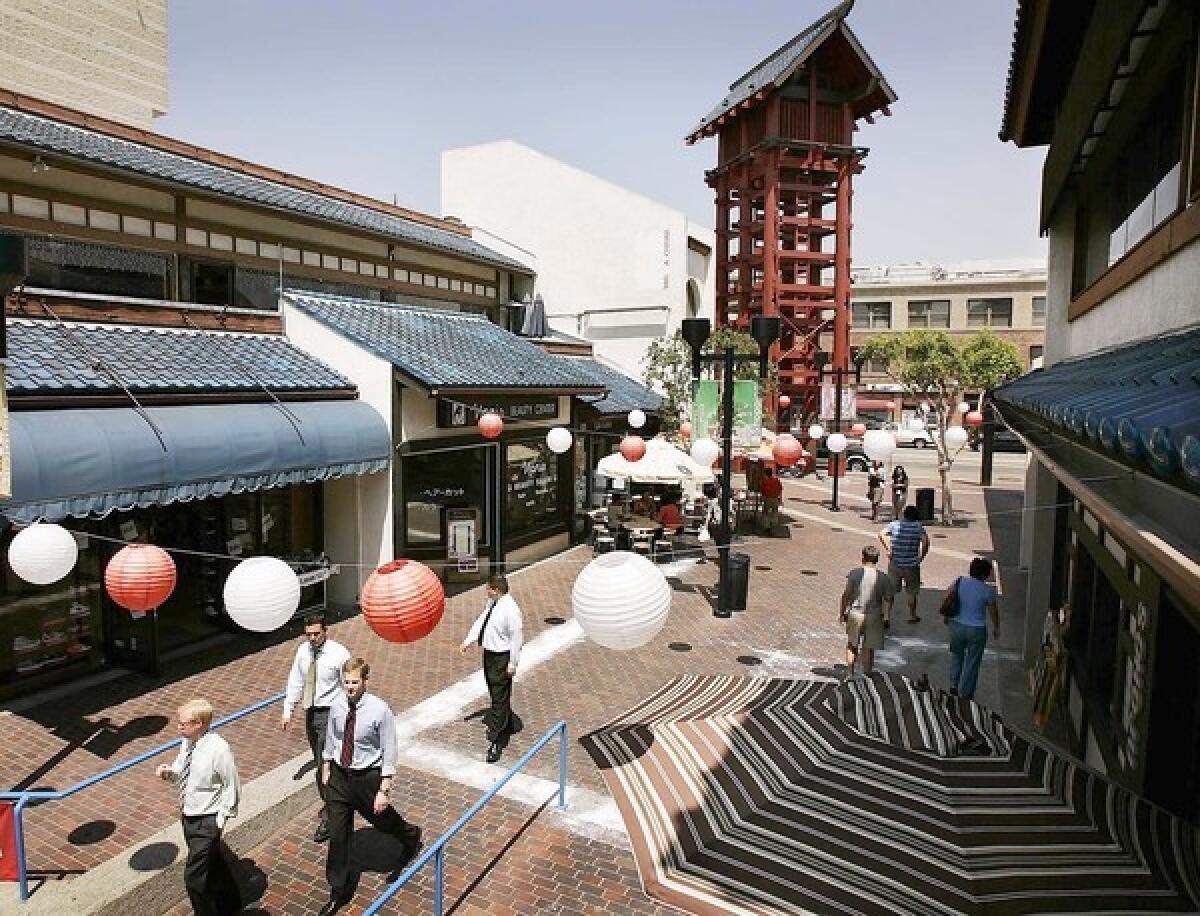The streets are alive

“What brings you downtown?” the waitress asks as she seats me on a patio shadowed by the skyscrapers on Bunker Hill.
I hear this question often. “Actually, I live here,” I say, trying not to sound smug. “Just down the hill.”
“Oh!” the waitress chirps in surprise. After all, most of the restaurant patrons work in the neighboring office buildings on Grand Avenue or Hope Street. They may stop in for a drink before heading home to a house on a grassy lot fringed with oleander and bougainvillea, but they don’t live here.
The waitress tones down her chirp and asks, “What is it really like to live downtown?”
I concentrate as I formulate my answer. Downtown, I say, is a mélange of beautiful, curious and surprising sights. A neighborhood where I encounter an astounding variety of people. A place where I can interact with my immediate world. I finish with a simple observation: It all happens here.
She’s polite but unconvinced.
I’d like to explain that my mom and I moved downtown a year ago, after a buyer finally snapped up our high-maintenance Santa Monica Craftsman, which languished far too long on the market. We both yearned for freedom from spraying for termites and bees, uprooting bamboo invasions and hacking branches off ficus trees that served as a rat runway into our attic.
As a break, we had been spending Saturday afternoons exploring downtown and idly wondering what life might be like in a car-optional neighborhood, surrounded by up-close culture and L.A.’s skyline. I’m a college student, so local schools weren’t an issue. When suddenly and unexpectedly we closed escrow, we packed up for downtown, choosing our Little Tokyo apartment especially for its location at 2nd and San Pedro streets.
From there, it’s an easy walk to some of downtown’s other cool neighborhoods, such as the Arts District, Civic Center and the Historic Core. I love being surrounded by Japanese culture, but like the other downtown neighborhoods and L.A. itself, Little Tokyo is also about diversity and variety.
Each morning, tent dwellers on 3rd Street pack up on the stretch of sidewalk that was home the preceding night. Some amble over to the plaza across the street from my apartment, designed by Japanese American artist Isamu Noguchi. Skid Row, with its concentration of homeless, crime, drugs and chaos, is a big concern here. As if to remind us of this reality, sirens often dominate the city sounds.
But I’m aware of the more pleasant rituals of downtown life when the elderly Japanese from a neighboring apartment building gather on the plaza each morning for Tai Chi. Others stroll with parasols shading their faces from the sun. A group of teenage girls in sweatpants and tank tops, hair tied back in neat ballerina buns, arrive on the scene headed for dance class at a Colburn School studio right off the plaza. Teenage boys on skateboards follow on their heels, outdoing each other with daredevil spins and flips.
I take every opportunity to have an adventure, starting with the neighborhood restaurants.
On a short stretch of 2nd Street, Kokekkoko, Kouraku, and Raku serve entirely different Japanese menus. Or I could go for Korean cold noodles, Hawaiian barbecue or a Chinese lunch counter. Perhaps a Asian-Mexican food truck will appear. What about Mediterranean kebabs and sangria? Fish tacos?
In the afternoon, I walk Rocket, my border collie, in a loop around Little Tokyo’s Village Plaza to historic Main Street. With his intelligent, handsome face, Rocket attracts many admirers who stop to chat with me while scratching his floppy ears. Some downtowners complain about “dog splat,” but many believe the canine population has helped to create a community, encouraging residents to interact with their neighbors on the streets rather than staying cloistered inside. And besides, how else would I meet the cyclist who cruises the neighborhood with a sapphire parrot riding the handlebars?
I also drop in at the neighborhood markets, which offer an excellent selection of kimchi and plum wine. Yes, I often miss the endless aisles of breakfast cereals and laundry soaps of the super-sized grocery chains in Santa Monica. And, yes, I sometimes regress to the “drive and park” shopping style, traveling to the big market at the other end of downtown or even to the Westside. And I still haven’t found substitutes for my favorite dry cleaner, shoe repair shop, pharmacy and panaderia.
But every morning I give thanks to some higher power that I won’t spend another summer day hacking away at the oleander or fighting traffic. In Los Angeles, there’s too much else to do.
More to Read
Sign up for The Wild
We’ll help you find the best places to hike, bike and run, as well as the perfect silent spots for meditation and yoga.
You may occasionally receive promotional content from the Los Angeles Times.






